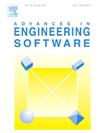Prediction of the limiting uniform normal pressure in deep contiguous piled walls using soft computing techniques
IF 5.7
2区 工程技术
Q2 COMPUTER SCIENCE, INTERDISCIPLINARY APPLICATIONS
引用次数: 0
Abstract
In urban civil engineering projects, deep contiguous piled walls are crucial for support and stability, particularly in limited spaces. This study employs advanced soft computing techniques, integrating FELA simulations, XGBoost, and optimization algorithms (PSO, GWO, and WOA), to predict the limiting uniform normal pressure behind circular and I-shaped contiguous piled walls in cohesive soil. The key factors in the prediction model include the soil properties, pile wall geometry, and soil strength parameters such as the spacing-to-width ratio (S/B or S/D), adhesion factor (m), height-to-width ratio of the I-section (H/B), and friction angle (φ). The sensitivity analysis reveals that for circular-shaped piles, φ is the most influential parameter (R = 0.69, Ri = 47 %), followed by the m and S/D, with moderate impacts (R = 0.49 and 0.28, Ri = 34 % and 19 %, respectively). For I-shaped piles, the m has the highest effect (R = 0.52, Ri = 28 %) followed by the S/B (R = 0.49, Ri = 26 %), H/B (R = 0.45, Ri = 24 %) and φ (R = 0.41, Ri = 22 %). The predictive performance of the constructed model was assessed using several performance metrics, regression plot, residual error histogram and regression error characteristic (REC) curve. The hybrid XGBoost-WOA model is identified as the most effective for both circular and I-shaped piles based on various performance metrics (R2, RMSE, MAE, WMAPE, VAF, and PI) and error analyses. This approach aims to improve prediction accuracy and address the limitations of traditional methods in deep contiguous piled wall design.
用软计算技术预测深层连续桩墙极限均布正压
在城市土木工程项目中,深层连续桩墙对于支撑和稳定至关重要,特别是在有限的空间中。本研究采用先进的软计算技术,集成FELA模拟、XGBoost和优化算法(PSO、GWO和WOA),预测了粘性土中圆形和i形连续桩墙后的极限均匀法向压力。预测模型的关键因素包括土体性质、桩壁几何形状和土体强度参数,如间距比(S/B或S/D)、黏附系数(m)、工字段高宽比(H/B)、摩擦角(φ)等。敏感性分析表明,对于圆形桩,φ是影响最大的参数(R = 0.69, Ri = 47%),其次是m和S/D,影响中等(R = 0.49和0.28,Ri分别= 34%和19%)。对于工字形桩,m的影响最大(R = 0.52, Ri = 28%),其次是S/B (R = 0.49, Ri = 26%)、H/B (R = 0.45, Ri = 24%)和φ (R = 0.41, Ri = 22%)。采用多个性能指标、回归图、残差直方图和回归误差特征(REC)曲线对构建模型的预测性能进行评估。基于各种性能指标(R2、RMSE、MAE、WMAPE、VAF和PI)和误差分析,XGBoost-WOA混合模型被认为对圆形和i形桩都是最有效的。该方法旨在提高预测精度,解决传统方法在深层连续桩墙设计中的局限性。
本文章由计算机程序翻译,如有差异,请以英文原文为准。
求助全文
约1分钟内获得全文
求助全文
来源期刊

Advances in Engineering Software
工程技术-计算机:跨学科应用
CiteScore
7.70
自引率
4.20%
发文量
169
审稿时长
37 days
期刊介绍:
The objective of this journal is to communicate recent and projected advances in computer-based engineering techniques. The fields covered include mechanical, aerospace, civil and environmental engineering, with an emphasis on research and development leading to practical problem-solving.
The scope of the journal includes:
• Innovative computational strategies and numerical algorithms for large-scale engineering problems
• Analysis and simulation techniques and systems
• Model and mesh generation
• Control of the accuracy, stability and efficiency of computational process
• Exploitation of new computing environments (eg distributed hetergeneous and collaborative computing)
• Advanced visualization techniques, virtual environments and prototyping
• Applications of AI, knowledge-based systems, computational intelligence, including fuzzy logic, neural networks and evolutionary computations
• Application of object-oriented technology to engineering problems
• Intelligent human computer interfaces
• Design automation, multidisciplinary design and optimization
• CAD, CAE and integrated process and product development systems
• Quality and reliability.
 求助内容:
求助内容: 应助结果提醒方式:
应助结果提醒方式:


